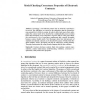Free Online Productivity Tools
i2Speak
i2Symbol
i2OCR
iTex2Img
iWeb2Print
iWeb2Shot
i2Type
iPdf2Split
iPdf2Merge
i2Bopomofo
i2Arabic
i2Style
i2Image
i2PDF
iLatex2Rtf
Sci2ools
ICSOC
2003
Springer
2003
Springer
Model Checking Correctness Properties of Electronic Contracts
Converting a conventional contract into an electronic equivalent is not trivial. The difficulties are caused by the ambiguities that the original human-oriented text is likely to contain. In order to detect and remove these ambiguities the contract needs to be described in a mathematically precise notation before the description can be subjected to rigorous analysis. This paper identifies and discusses a list of correctness requirements that a typical executable business contract should satisfy. Next the paper shows how relevant parts of standard conventional contracts can be described by means of Finite State Machines (FSMs). Such a description can then be subjected to model checking. The paper demonstrates this using Promela language and the Spin validator.
| Added | 07 Jul 2010 |
| Updated | 07 Jul 2010 |
| Type | Conference |
| Year | 2003 |
| Where | ICSOC |
| Authors | Ellis Solaiman, Carlos Molina-Jiménez, Santosh K. Shrivastava |
Comments (0)

